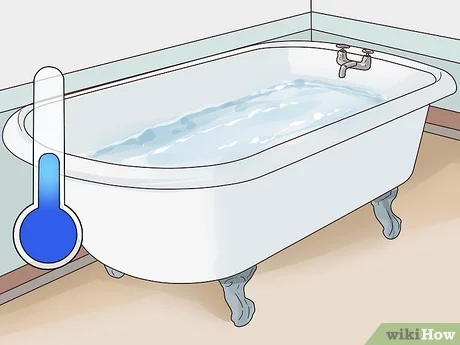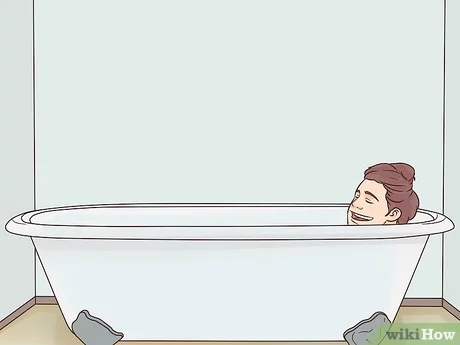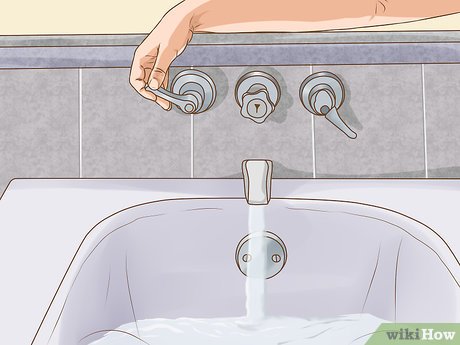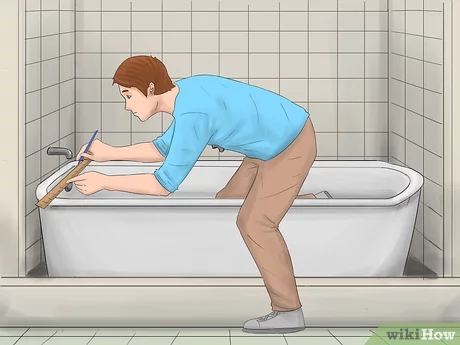Как установить ванну (с изображениями) — wikiHow
Installing a bathtub is a complex job that shouldn’
Установка ванны — это задача, которую новичкам лучше не браться выполнять. Однако, если у вас есть некоторый опыт в сфере сантехники и строительства, это может быть проектом, который вы почувствуете себя уверенно осваивать самостоятельно. Если вы ищете точку отсчета, в данном руководстве предоставлена структура выполнения этой задачи. Если на каком-либо этапе вы сомневаетесь в действиях, лучше вызвать сантехника. Они могут установить ванну для вас и гарантировать, что всё будет сделано по соответствующим нормам.

-
Turn off the water at the main line. The first step is to shut off the water for the bathroom you’ll be working in. Locate the main line and turn it all the way off. Then, turn on the faucet in your tub to drain the lines.[1]
-
Remove the accessories and disconnect the water lines. Use a screwdriver to unscrew the faucet and disconnect it from the water lines by unscrewing it. Remove the handles, overflow drain cover, and the drain cover on the bottom of the tub. If you have a showerhead, remove that as well.[2]
- You may need to pry off a plastic cover to gain access to the screws.
- You may be able to reuse some of these accessories, so keep them if you don’t want to buy new ones.
Advertisement
-
Remove the existing tub surround or tiles. You need to expose the studs in the wall in order to install a new bathtub, so you must remove the existing surround and the drywall behind it. Using a utility knife, cut through the drywall around the outside edge of the entire surround. Then, use a pry bar to pry the drywall and surround or tiles out of place. Be careful not to damage any pipes or wires![3]
- Be sure to wear safety gear, including goggles and a dust mask, throughout this process.
- Work from the top of the surround down to the bottom.
-
Gain access to the plumbing. In some homes, you may be able to access the plumbing from the room next to the bathroom. In other cases, the plumbing may be situated in the floor under the tub. Most likely, you’ll need to cut a hole in the wall or floor in order to access the plumbing.[4]
-
Take out the old tub. First, unscrew the tub drain and overflow from the P-trap underneath the tub.[5] If your tub is acrylic or fiberglass, cut it into pieces with a jigsaw to make the removal process easier. If you want to try to keep the tub in one piece, use a jigsaw to cut away the tub flange that’s nailed to the studs, then tip up the tub and pull it out.[6]
- You may need to slice through the caulk that connects the tub and floor before removing the tub. Use a utility knife to do so.
- As you do this, check and see if you need to replace any damaged parts.
Advertisement
-
Select a tub that will fit in the designated space. Measure the length and width of the alcove where you will install the tub. Also, measure the height and width of your bathroom doorway to make sure the tub will fit through the bathroom door! Take your measurements to a home improvement store to guide your purchase.
- If you’re replacing an old tub, choose a new tub with a similar configuration and make sure the drain and faucets are on the same side and in roughly the same location to make installation easier.
- Make sure your tub comes with all the faucets, drains, and accessories you will need. Typically, you’ll need a faucet, water handle(s), and the drain, which includes the drain chute, strainer, strainer cover, trip lever, stopper, linkage, and overflow drain cover.
- If needed, remove any toilets or sinks that might get in the way of the installation.
-
Dry-fit the tub in the alcove. To ensure the tub fits, place it in the designated area. Check that the drain hole in the bottom of the tub lines up with the P-trap in the floor underneath the tub. Ensure you have the right fittings to connect the water supply lines to the faucet you purchased, as well.[7]
- Set the tub somewhere safe after you make sure it fits so you can move onto installing a ledger board.
- Use caution to prevent scratches or other damage to your new tub!
-
Install a ledger board. Cut a 2 by 4 in (5.1 by 10.2 cm) board to the length of the wall that the long edge of the tub will be placed against. Measure the height of the lip, or flange, of the tub, then mark that height measurement on the back wall. Use a drill to screw the ledger board to the studs in the wall so that the top of the ledger board is just below the flange when the tub is sitting level in the alcove.[8]
- A ledger board helps support the weight of the tub and ensures it can be securely attached to the wall.
-
Attach the drain to the tub. Before you actually set the tub in place, secure the drain to it. Wrap the bottom of the strainer (the part of the drain you see on the inside of the bottom of the tub) with plumber’s putty and press it into the tub from the inside. Place a gasket around the strainer from the outside of the bottom of the tub, then screw the strainer to the drain chute, which a long pipe that includes the overflow drain.[9]
- Use pliers to tighten the strainer from the inside of the tub and remove any excess putty.
-
Connect the overflow drain. Slip the trip lever stopper and linkage through the overflow drain opening on the inside of the tub. Use a screwdriver to secure the overflow cover with the trip lever to the inside of the tub.[10]
- The trip lever is what you move up to prevent water from draining out of the tub. The stopper and linkage go inside the pipe to stop or allow the flow of water.
- The overflow drain will prevent the tub from overflowing if you leave the water running as it directs the water into a drain pipe.
Advertisement
-
Set the tub in place and level it. Carefully position the tub in the alcove so that the drain rests over the drain opening in the floor. Place a level on each side of the tub. If any spots are uneven, position hardwood shims underneath the tub and glue them in place.[11]
- Some manufacturers may advise you to spread mortar on the floor and set your tub on the mortar to secure it in place.
-
Secure the tub to the studs. There will be a small flange, or vertical lip, around the outside of the tub. Follow the manufacturer’s directions to secure the flange to the studs in the wall. In most cases, you can use a hammer to drive roofing nails through the flange to secure it to each stud in the wall.[12]
-
Fit a new tub surround. The surround is made up of the panels that protect the wall around your tub from moisture and mildew. First, dry-fit the surround and mark the location of the accessories, including the faucet and water handles. Ensure that the faucet will line up with the water lines in the wall. Then, cut out the accessory openings with a jigsaw.[13]
- Make sure you measure the location for accessories multiple times before cutting into the surround!
- A one-piece surround is the easiest type to install.
-
Caulk the tub to the surround and secure the surround to the studs. Place a bead of silicone caulk around the entire perimeter of the tub on the ledge next to the flange. Then, carefully set the surround on top of the silicone caulk. Next, use a drill to screw the surround into each wall stud. Aim to use a screw every 6 inches (15 cm) up the length of the surround.[14]
- Be sure to choose silicone caulk meant for use in bathrooms.
-
Connect the water lines and install your accessories. Screw the faucet into the coupling for the water lines through the hole in the surround. Then, screw the strainer cover over the drain opening in the floor of the tub. Add any other accessories you need, such as handles if they are separate from your faucet.[15]
-
Connect the drain to the P-trap. Thread the drain chute into the P-trap under the tub. You may need to use PVC pipe to connect the drain chute to the P-trap if they don’t align perfectly. If that’s the case, dry-fit the pieces first and secure the PVC pipe to the chute and P-trap with ABS cement to prevent it from coming loose.[16]
-
Caulk the tub to the floor. Run a bead of silicone caulk along the outside edge of the tub where it meets the floor. Make sure it meets both outside corners to prevent water from getting in between the tub and floor. Smooth out the bead with your finger or a damp rag.[17]
-
Wait 24 hours before turning on the water. To give the caulk and other adhesives time to dry, wait at least a full day. Then, you can turn on the water and check for leaks. If you find any problems, contact a certified plumber.[18]
Advertisement
-
Question
Do you drywall to the floor around the bathtub?
Yes, I do, cement-board actually. Never use ANY drywall in any bath. Many manufacturers say skip it and attach or seat directly to the framing. This isn’t remotely ideal for humidity containment nor for insulation or sound dampening. You never want framing directly exposed to any future potential water leakage, water always wins.
-
Question
I want to put a bath tub in. I live on the 4th floor and currently only have a shower. Can I use the same drainage hole for the bath that is already there for the shower?
Shower drains should be 2″ and tub drains are 1-1/2″ so you are good there, but the pipe will have to be moved to be in the correct position for the new tub.
-
Question
If I’m installing a fiberglass surround bathtub. Do I have to put a cement board behind it?
No. It can be attached directly to the studs. Where the flange is, all around the tub, should be set into the studs the thickness of the flange so the wall board around it will be flat and against the studs everywhere. Drill the flange for the screws so you do not crack the fiberglass. Doing that will keep the wall along the bath surround flat everywhere. Be sure that those walls are insulated. Also be sure the bottom of the tub is supported with concrete that is mixed with peanut foam. Insulate the rest of the bottom of the tub. Insulation will keep the bath water warmer longer.

See more answers
Ask a Question
200 characters left
Include your email address to get a message when this question is answered.
Advertisement
-
Since tile damage is a given with this sort of project, you might want to select and purchase your replacement tiles beforehand. This helps speed up the process!
Advertisement
-
Wear appropriate safety gear, such as goggles and a dust mask.
Advertisement

Things You’ll Need
- Goggles
- Dust mask
- Utility knife
- Pliers
- Screwdriver
- Hammer
- Pry bar
- Roofing nails
- Pencil or marker
- Jigsaw
- Silicone caulk
- Caulk gun
- Drill
References
About This Article
To install a bathtub, start by installing a 2- by 4-inch ledger board to the length of the wall that the long edge of the tub will be against. Then, attach the drain to the new tub, and connect the overflow drain. Next, set the tub in place, and secure it to the studs using the vertical lip around the outside of it. Once you‘ve done that, fit a new tub surround, and caulk to the tub to it. Finally, connect all of the water lines and accessories, and caulk the tub to the floor. To learn how to remove an old bathtub, read on!
Did this summary help you?
Thanks to all authors for creating a page that has been read 291,208 times.
Reader Success Stories

-
Omenty Siampazanga
Jul 31, 2020
«Teaching me new techniques which advance my professionalism.»
Did this article help you?
Где поставить свечи?
Место, где следует поставить свечи, зависит от того, как вы планируете их использовать и в какой обстановке. Некоторые общие рекомендации по размещению свечей в разных местах могут быть следующими:
-
В гостиной: свечи могут добавить уют и атмосферу в гостиную. Их можно поставить на стол или на полку, чтобы создать приятный свет и аромат. Также можно разместить несколько свечей на столе для кофе или бокальчиках с вином.
-
В спальне: свечи могут помочь создать расслабляющую атмосферу в спальне. Их можно поставить на ночной столик или на комод рядом с кроватью.
-
В ванной комнате: свечи могут помочь создать романтическую или спокойную атмосферу во время ванны или душа. Их можно поставить на край ванны или на полку, рядом с зеркалом.
-
На кухне: свечи можно использовать для создания атмосферы во время ужина или вечеринки. Их можно поставить на стол или на кухонный остров.
-
На балконе или веранде: свечи можно использовать для создания атмосферы на открытом воздухе. Их можно поставить на стол или на полу рядом с мебелью для отдыха.
Независимо от места, где вы решите поставить свечи, не забывайте обеспечить безопасность и не оставляйте горящие свечи без присмотра.